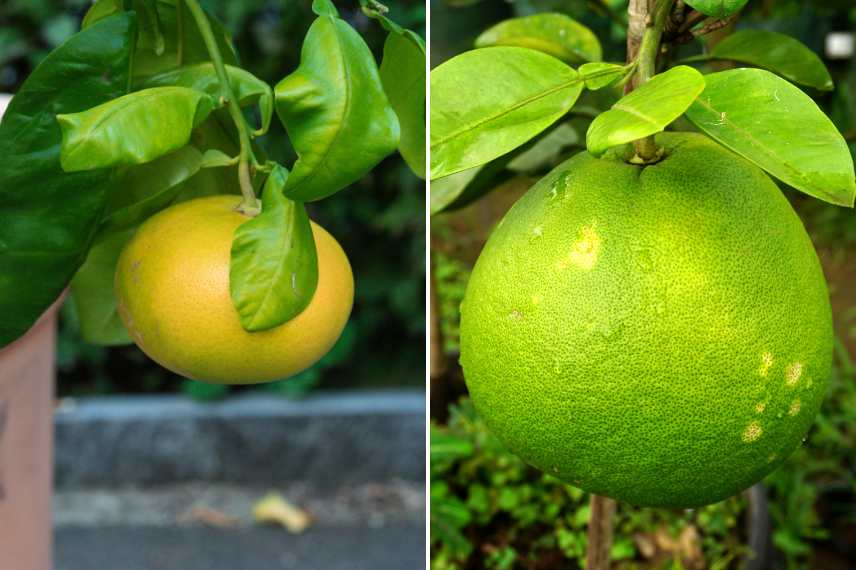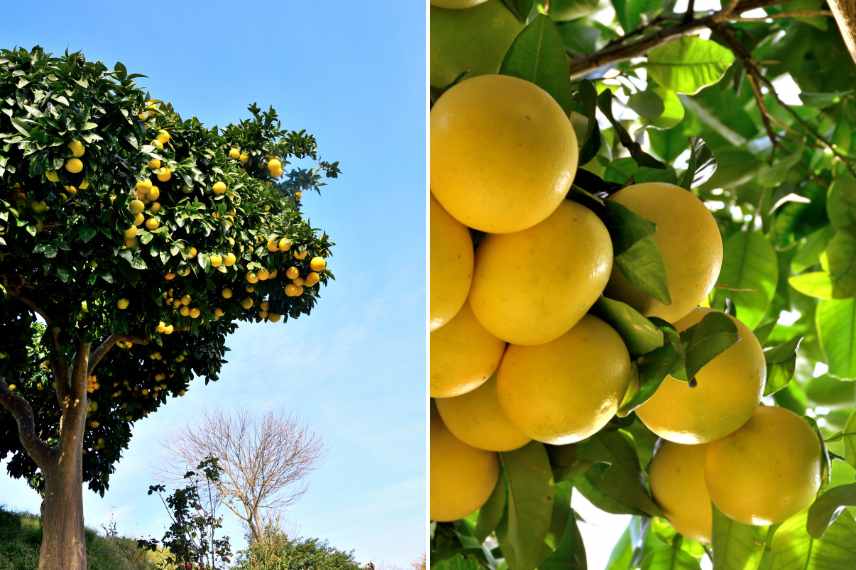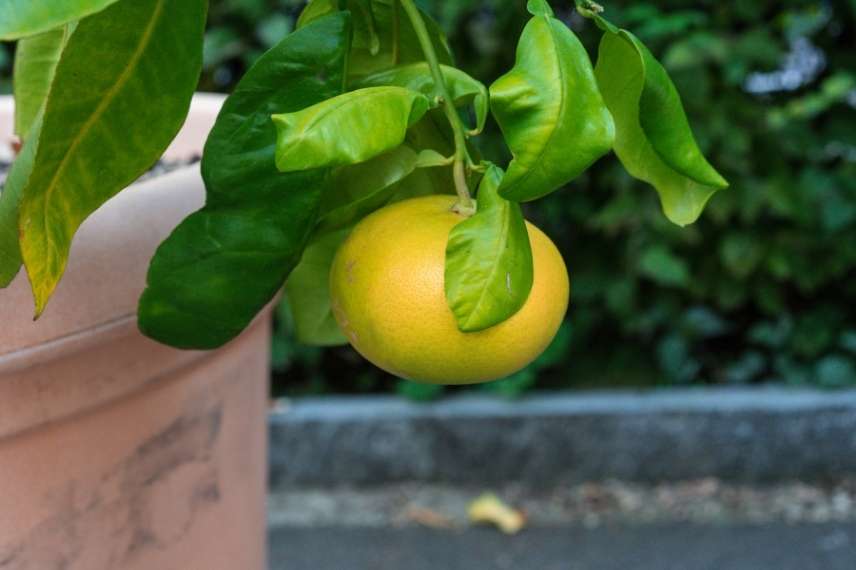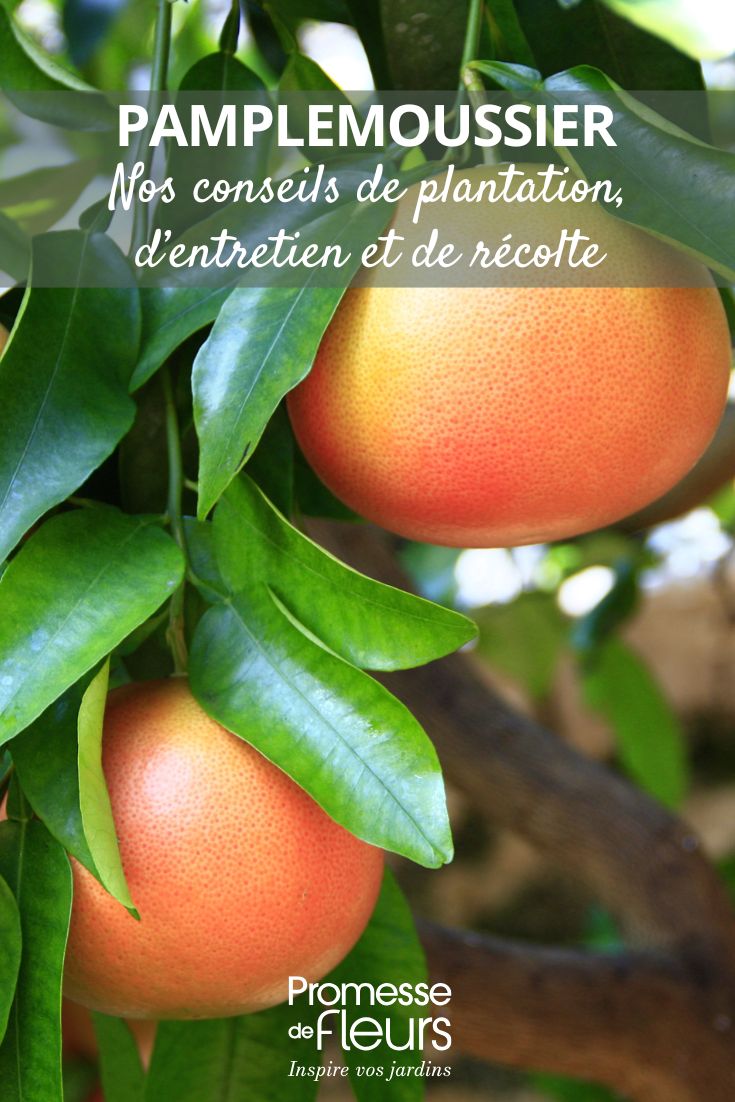
How to grow grapefruit trees?
Planting, care, harvest... everything you need to know about growing grapefruit trees
Contents
If you enjoy fruits that combine sweet, bitter, and tangy flavours, you must love pomelos. Naturally, you consume them regularly. But did you know that a long-standing confusion persists about this pomelo we find on our shelves, which isn’t entirely one? Regardless, this citrus from the genus Citrus is quite easy to grow in our latitudes, planted directly in the ground along the Mediterranean coast, or in pots and overwintered in a conservatory elsewhere.
Discover all our tips for planting and caring for the pomelo tree to enjoy a bountiful harvest!
Grapefruit or pomelo: how to choose?
The grapefruit and the pomelo… When you choose your fruit at the greengrocer’s, you often see both names. At first glance, you might think they are the same citrus tree with a flavour that is sweet, bitter, and tangy all at once. Not at all! This is a confusion that has persisted for many years and is likely to continue for a long time. However, if you’re considering growing a grapefruit tree, an explanation is in order to avoid disappointment!
Indeed, the grapefruit we commonly consume is actually a pomelo, the fruit of Citrus x paradisi, a natural hybrid between a grapefruit tree (Citrus maxima) and a sweet orange (Citrus sinensis). These pomelos are distinguished by their relatively thin epidermis, usually coloured yellow-orange, and their juicy flesh, tinged with pink or yellow depending on the variety. Meanwhile, the true grapefruit is the fruit of the true grapefruit tree (Citrus maxima), which produces significantly larger fruits, often pear-shaped, with thick yellow or greenish skin. These are generally sold under the name “Chinese grapefruits.”

On the left, the pomelo; on the right, the true grapefruit
The difference between these two fruits lies mainly in their flavour: the grapefruit is distinctly more bitter and less sweet than the pomelo.
While the difference between the two citrus trees is clear, it is also evident between the two trees themselves. The pomelo is a tree that rarely exceeds 6 metres in height (in open ground) with a spread of 5 metres. Meanwhile, the grapefruit tree easily reaches 10 metres with a spread equivalent to that of the pomelo. Both species produce white, star-shaped, divinely fragrant flowers. In the pomelo, these inflorescences are clustered, while in the grapefruit tree, they are solitary. Additionally, in the grapefruit tree, the flowers and young shoots are slightly downy.
Nevertheless, grapefruit trees and pomelos are cultivated in the same way. In the rest of our article, for convenience, we will use the term “grapefruit tree” to refer to both trees.
Planting the Grapefruit Tree in the Ground: Where, When, and How?
Hardy down to -5 to -7°C, the grapefruit tree can only be grown in the ground in the south of France, along the Mediterranean coast, and in Corsica. It may also thrive in the warmest regions of the Atlantic coast. Indeed, the fruits, which ripen between November and March-April, could suffer from even the slightest frost. Moreover, they require a minimum amount of warmth to reach ripeness.
When to Plant?
Ideally, planting should take place between March and April, once all risk of frost has passed.
Where to Plant?
The grapefruit tree needs a sunny and warm location, well sheltered from winds and cold drafts. To prevent its foliage from burning, the grapefruit tree can tolerate a bit of shade during the hottest hours of the day. It is also essential to plant it away from sea spray.
In terms of soil, the grapefruit tree thrives in fertile, well-drained, and slightly acidic soil. A neutral soil may also suit it, as the grapefruit tree is often more adaptable than other citrus trees. However, avoid chalky soil for the grapefruit tree!

Grapefruit trees reach 6 to 10 m in height depending on the species
How to Plant?
- Soak the grapefruit tree’s root ball in a large basin of water
- Dig a planting hole two to three times the size of the root ball
- Mix the excavated soil with well-rotted compost or thoroughly decomposed manure and special citrus compost. You can add some sand for drainage if the soil is too heavy and compact
- Place a layer of coarse gravel or pumice at the bottom of the hole
- Fill half the hole with the excavated soil
- Place the grapefruit tree’s root ball in the centre of the planting hole
- Fill in with the remaining soil, ensuring the graft point is not buried
- Firm the soil and water generously
- Mulch to retain moisture and reduce the frequency of watering.
Planting a Grapefruit Tree in a Pot: Where, When, and How?
If you live outside the Mediterranean region, planting the pomelo tree in a pot is essential. It should be moved outdoors in spring, once the risk of frost has passed, until September or October.
When to Plant?
Planting the pomelo tree in a pot is also done in spring, between March and April.
Where to Plant?
To grow a pomelo tree in a container, choose a perforated pot, large enough, at least 30 cm deep and wide.
The growing medium should be light, rich, perfectly drained, and neutral to acidic. Ideally, a special citrus compost is recommended to provide the best growing conditions for your pomelo tree. However, a mixture consisting of compost (40%), well-decomposed compost (40%), and sand (20%) can work perfectly.

The pomelo tree thrives in pots in our latitudes
It should be placed in a spot that gets plenty of morning sun and light shade in the afternoon, especially during the height of summer.
How to Plant?
- Soak the root ball in a bucket of water
- Place a good layer of clay pebbles, coarse gravel, or pumice at the bottom of the pot
- Fill half the pot with the growing medium
- Position the pomelo tree’s root ball in the centre, ensuring the roots are slightly loosened
- Fill in with the growing medium without burying the neck
- Firm with your hands and water generously
- Mulch.
What care does the grapefruit tree require?
The grapefruit tree requires constant care, primarily focused on watering and fertilisation. Light pruning is also necessary.
Watering the grapefruit tree
The grapefruit tree is thirsty, especially when grown in a pot.
For the first two to three years after planting, your grapefruit tree should be watered almost daily during periods of intense heat, and two to three times a week in spring. In autumn and winter, watering should be reduced depending on rainfall frequency. Once your grapefruit tree is well established, watering may become less frequent but should remain very regular.
A potted grapefruit tree should be watered almost every day in spring and summer, and once a week in autumn and winter.
For watering citrus trees, rainwater is always preferred, or, failing that, non-calcareous water. Never allow residual water to remain in the saucer or decorative pot.
Fertilising the grapefruit tree
Beyond being thirsty, the grapefruit tree is greedy. If grown in the ground, an application of compost or organic fertiliser specially formulated for citrus trees is recommended in spring and autumn. For potted trees, the substrate should be enriched, from March to October, with a liquid fertiliser for citrus trees once a month. A slow-release fertiliser specifically designed for citrus trees is also suitable, but be sure to follow the instructions on the label.
Pruning the grapefruit tree
The grapefruit tree should be lightly pruned once a year, in May or June. Simply use pruning shears to trim the new shoots to stimulate flowering and fruiting. This pruning also helps maintain a rounded and compact habit.
Protection against cold
In regions where hardiness is borderline, grapefruit trees planted in the ground should be protected with a winter fleece and a good mulch of dry leaves at the base.
Potted grapefruit trees should be brought indoors from October, into a frost-free but unheated room. A conservatory, cold greenhouse, or winter garden is perfect, provided they receive enough light, with temperatures between 7 and 10-12°C.
Repotting the grapefruit tree
If its size allows, the grapefruit tree should be repotted every two years, or three years at most. If it is too large and heavy, simply top-dress with a special citrus compost.
How to manage diseases and pests affecting grapefruit trees?
Like all other citrus trees, the grapefruit tree can be susceptible to certain diseases (mal sec, gummosis, sooty mould, tristeza…), often caused by poor growing conditions, as well as numerous pests.
To protect it from diseases, the key is to provide regular fertilisation and watering. A spray of Bordeaux mixture or horsetail decoction can be beneficial in autumn and spring. Also, remember to properly seal pruning wounds with a pruning sealant.
As for pests, they are plentiful too: scale insects and aphids thrive on grapefruit trees, as do spider mites or whiteflies. Not to mention the Mediterranean fruit fly which attacks the fruits. Vigilance is essential, as is maintaining optimal growing conditions, especially indoors.
When does the grapefruit harvest take place?
Depending on the region, the harvest of grapefruits or pomelos extends from November to March. Keep in mind that the fruits take about 9 months to reach ripeness and, above all, require a lot of heat.
- Subscribe!
- Contents
































Comments